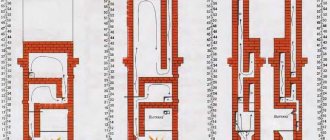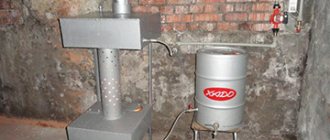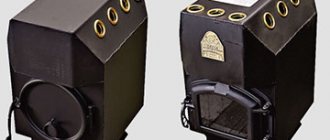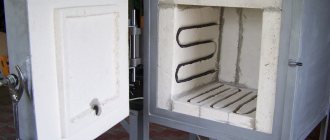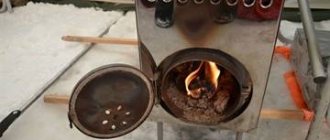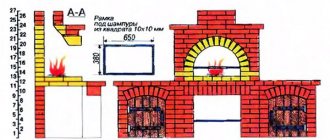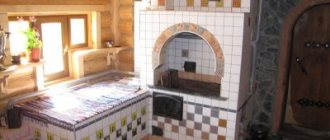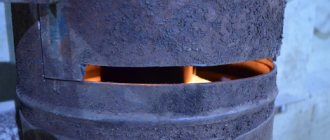Firewood and coal remain in many regions the most affordable types of fuel used to heat private cottages. However, stove heating is chosen not only because of the low cost and availability of energy, but also because of the low cost of its installation.
Moreover, in addition to many advantages, a stove with a water circuit for heating a house also has a lot of disadvantages. This option is not always optimal. Let's try to understand the nuances of such a heating system.
Advantages of a stove with a water heating circuit
The advantages of this option include:
- Availability and cheapness of fuel (wood, coal);
- Low cost of installation and operation;
- Reliability, durability;
- Independence from power supply;
- The ability to perform several functions (heating and cooking, and factories offer such a variety as a fireplace stove with water heating).
In comparison with the classic version (a stove without a circuit), uniform heat transfer throughout the house and rational fuel consumption are achieved here.
Homemade gas generators
The most popular homemade long-burning stoves with a water circuit, made on the basis of Stropuva, are Bubafonya. Drawings can be easily obtained on the RuNet. Here there is vertical combustion, and the stages of pyrolysis are mixed and occur everywhere and at once.
The air supply is carried out through a central small tube located in a pancake - a pressure that prevents gases from escaping upward.
The lower part of the pancake must have curved blades - they are needed so that the released gases linger a little, swirl on the surface and have time to burn out before flying out into the chimney. The chimney is taken out to the side and combined with a condensate collector.
Homemade Bubafonya
Cons you need to know about:
- The stove is not compatible with coal and pellets.
- The efficiency of Bubafoni will not reach 80%.
- You can't cook on it.
- You need to wait for the fuel to completely burn out in order to clean the boiler and only then fire it up again. Judging by the reviews, this technology does not perform well in cold weather. The heat from the remaining fuel is no longer enough - you have to wait and feel cold.
- Cleaning and adding fuel is inconvenient and difficult.
If you connect Bubafonya to a water circuit, then the heat exchanger must be installed at some distance from the walls of the boiler. It is also necessary to construct a protective screen (it will also increase the efficiency of the furnace), since the walls become hot and red.
Disadvantages of a water-heated furnace
The design also has several disadvantages:
- It takes time to warm up before the system begins to dissipate heat;
- A lot of heat escapes through the pipe (low efficiency);
- Risk of fire if the device is not used correctly;
- The stove is capable of heating only a one-story dwelling, within 150 m2.
Important! If the premises are not heated in winter, it is advisable to fill the system with antifreeze instead of water. This will prevent possible freezing and rupture of pipes.
Material
Typically, brick is used in the construction of stoves. It is characterized by a number of features. This design is heavy (from 1.5 to 10 tons) and requires a prepared, solid foundation. Due to the massiveness of the unit, a lot of usable space in the room is lost.
The optimal installation option is when the house is still under construction. In this case, it is easier to think through everything and optimally arrange the circuit. Designing in already finished housing creates difficulties: you have to create a solid foundation.
A brick stove with water heating takes a long time to heat up, but also releases heat more slowly. Thanks to this, the rooms are kept warm for many hours.
An alternative to brick is steel; potbelly stoves are made from it. The nuances of such designs:
- Light weight (100-300 kg) and compact, do not require much space, they can be placed on a regular floor;
- They are installed not only at the construction stage, but also in completed houses;
- The body heats up quickly and quickly releases heat, so the owner will have to heat it more often.
Features of stove masonry
To build a stove, select a suitable building material. Normally fired brick is considered the best option, but for the walls of the combustion chamber and smoke duct it is better to buy refractory brick.
Kiln masonry
- Before laying a brick, it is immersed in water and held until air bubbles stop appearing;
- Each row and corner must be tied;
- The solution is applied immediately along the entire row, in a layer of approximately 5 mm, and on the end of each brick immediately before laying;
- When laying the firebox, it is recommended to distribute the clay solution not with a trowel, but with your hand;
- Having laid about 5 rows, carefully cut off the mortar between the seams and rub the seam with a wet sponge;
- Of course, the verticality and horizontality of the walls being erected must be controlled.
Important! It is imperative to ensure unobstructed access to the combustion chamber and pay attention to safety. Only fireproof materials are used in and around the stove.
Do you need electricity?
The system can be implemented in two versions:
- Free circulation when heating occurs by gravity;
- Forced way.
In the latter case, a pump and a battery will be required (provide uninterrupted power supply). At first glance, this is convenient: after all, stability is maintained. You can heat not only the first floor, but also other floors.
However, such components significantly increase the cost of stove heating; the design itself acquires impressive dimensions.
Fuel
The following types of raw materials can be used:
- Coal (brown, stone, reach temperatures of 1500 degrees);
- Logs (the most accessible, with a long shelf life and low cost);
- Fuel briquettes (they are convenient to store, burn for a long time and evenly).
By the way. Which resource to choose depends on personal preferences. This parameter does not affect the furnace design.
What pipes are needed?
Instead of radiators, pipes (80-120 mm in diameter) are usually used. They are better suited for stoves (provide sufficient water volume in the system).
The main thing here is to choose the right material:
- Stainless steel;
- Metal-plastic;
- Polypropylene.
On a note! For brick stoves heated by wood, the best option is steel. It can withstand high temperatures (up to 100 Cº or more). Other materials are not designed for this load (maximum 95 Cº).
Circuit
The pipeline consists of a supply from the furnace and a return to it. In the room farthest from the stove, both branches are connected. In other rooms they run in two lines along the outer walls.
On a note! This option is cheaper than a system with radiators and is easier to install.
Recommendations for placing heating system elements
Elements of the heating system can hardly be called decoration of a modern interior. Only pipes that look organic in some industrial interiors can fit this definition. In general, building codes and architectural principles recommend placing parts in areas that are hidden but accessible for repair and maintenance. When placing, they are guided by the following rules:
- The heat generator is placed in an isolated room with heating and good ventilation. The circulation pump must operate under the same conditions. Small boilers (with a power of up to 30 kW) can be installed in the kitchen, hallway, basement or warm heated extension. Stoves intended for residential premises are installed taking into account fire safety rules.
- The place for an open type expansion tank is in the attic ; supply and collection pipelines tend to be located along the main wall structures.
Compliance with operating rules helps the smooth operation of the system Source yandex.ru
- The main riser runs openly in the corners of the living quarters ; in the attic it is covered with thermal insulation.
- Radiators are installed openly under window openings . They participate in room circulation, heating the cold air coming from the windows. Attempts to decorate radiators with decorative screens are undesirable, since they reduce the thermal efficiency of the system.
Heat exchanger
Various materials are used for stoves with water heating boilers:
- Low-carbon steel, in the form of a coil of pipes with a diameter of 4 to 5 cm (or an assembly of sheet steel, up to 0.5 cm thick);
- Cast iron, use old batteries made from it, preferably compact in size (to fit in the firebox);
- Copper (the most expensive option).
A tubular steel device is more efficient in operation, but more difficult to manufacture. Disadvantage of cast iron products: they are difficult to clean from accumulating soot (ribs get in the way). Copper cameras are rarely used, they are difficult for the owner to assemble, and expensive to purchase.
By the way. The heat exchanger significantly reduces the usable area of the firebox. There must be a gap between them - up to 15 mm (for products made of sheet steel - up to 10 mm).
What do we usually expect from a fireplace?
When we - you, me or anyone else - sitting in front of a computer screen, drawing our project or just thinking about the topic of heating a house, think about a fireplace and heating a house (especially if we think about the first and second at the same time), we often forget the primary expectations from the fireplace itself. Firstly, we forget the difference between an open fireplace and a fireplace with a door. And it is significant if the door is ordinary. The fact is that fireboxes come in “grate” and “hearth” types. I recently wrote a separate article about this, “Modern fireplace door with fireproof glass - important features!”
Many people know very well what the beauty of open fireplaces is. But it's unlikely that many people can distinguish between the important features of a fireplace insert (or any fireplace with a door) and an open fireplace. And even more so, fewer people will be able to choose a door behind the glass of which the fireplace will burn with the effect of an open fireplace - a good hearth door. The vast majority of steel fireplaces and any fireplaces with doors are grate. This is required for heating efficiency. The combustion in them is completely different; the aesthetics of burning wood in them will never compare with an open fireplace or a fireplace with a good hearth door.
Secondly, here is my personal experience and the experience of my colleagues. In order not to constantly put off starting the fireplace and generally be able to enjoy the view of the flame, the fireplace should be located in the most visible place in the living room. Also, he should not occupy a key place - so as not to get in the way. This is, of course, obvious, but when the question of the water circuit arises, we begin to scroll through the many placement options for profitable home heating. Often, we forget about the above-mentioned obviousness for the sake of heating efficiency.
Work order
You can make the equipment yourself or buy a factory unit.
When installing yourself, it is important to consider the following points:
- First, the heat exchanger is prepared;
- Then the circuit is mounted and connected to the thermal boiler;
- Before building a furnace, a pit is dug, then a layer of crushed stone and broken brick is made in it (the foundation should be 2-3 cm higher than the floor level);
- The furnace structure is being erected.
Preparation and selection of installation site
To begin, lay out all the materials in front of you. But we do this at the place where the stove is installed. We choose the latter like this. For maximum efficiency, the heat generator is mounted in the corner of the room so that the heat spreads across 2 walls and is not lost in 4 directions.
In this case, it is necessary to leave a small gap from the walls, equal to approximately 150 mm. If the stove is used in a country house, it is advisable to provide a chimney during its construction and run the upper section of the pipe through the roof.
There is no need to lay a foundation for our unit, because with the given parameters the weight will be small. If the stove is planned to be massive, then it is better to prepare a concrete base.
How to choose a factory model
The main indicator of a factory unit is power. For his home, the owner can make fairly accurate calculations using an online calculator. It is available on the official portals of most manufacturers.
When calculating the load, the following parameters are taken into account:
- Device location;
- House area;
- Unit operating time;
- Materials used in production;
- Installation conditions (thermal insulation and number of walls, ceiling height, degree of heating of the cellar and attic, number, dimensions of windows).
By the way! Prices for water-heated stoves vary, depending not only on power, but also on functionality (for example, it additionally plays the role of a fireplace).
The design of the furnace unit is not very complicated. The main thing here is to take into account all the nuances. If the structure is made of brick, then it is best to equip it at the stage of building the house.
In order not to depend on electricity, natural circulation is organized. The heat exchanger and circuit are usually made of steel; it can withstand high temperatures and will provide the highest possible efficiency. You can make the design yourself or purchase a suitable option in the store.
Recommendations for carrying out construction activities
When constructing a stove with a hob and a water circuit, the following standards must be adhered to:
- The stove and nearby surfaces must be separated by a safe distance. For these purposes, a metal sheet is additionally installed in front of the firebox to protect the floor and partitions.
- To make the masonry as strong as possible, every 4th row of bricks is reinforced with metal pins.
- A clay mortar of medium plasticity is used as a mounting mixture. A small ball rolled from it should not crack or crumble when it hits the floor.
- The chimney must have a height of at least 5 m: the presence of a head is a prerequisite. This element is designed to protect the chimney from climatic precipitation and blockages. In addition, it helps to increase traction and decorate the building.
Building a home stove with a boiler with your own hands usually does not cause any particular difficulties. Quite often you can find metal structures that are not inferior to brick ones in terms of external aesthetics. Such a product can greatly decorate a home interior. For the construction of brick kilns, a special building material is selected. The best option is fired ceramic red bricks. They are distinguished by their uniform color and metallic sound when tapped.
DIY construction
First, a project is prepared, after which a heat exchanger is made according to the drawings, which should subsequently be installed in the stove. Actually, the stove is built according to its dimensions.
When designing, you need to think about how the device will be located in the room. The place must be user-friendly and accessible to the public.
After the foundation is installed, the brick is prepared for laying. It must be fireproof, without any chips, damage or cracks. It is also necessary to provide in the project the location of the blower and combustion chamber, smoke exhaust, and hob. The latter may not be installed, it all depends on the preferences of the home owners.
Construction occurs in a certain order:
- First, a solution is prepared. It consists of water, clay and sand. This mixture can be purchased ready-made in specialized stores, but experienced craftsmen make it themselves.
- The foundation is insulated with a layer of film or roofing felt.
- A uniform layer of mortar is laid on top and the first rows of bricks are laid.
- A firebox and ash pan are being installed. The accuracy of the masonry must be checked using a building level.
- Next, the door is fixed and the vault is made. A chimney is also installed. For the walls of the chimney you need to use semicircular bricks.
- At the final stage, the water circuit is installed. Pipes and batteries are connected, as well as a heat exchange tank. After this, the liquid is poured. You can use plain water or prepared solutions.
You can also decorate the stove if desired. You can make an economical stove device yourself. Such a device is durable, has a high efficiency, so the house will receive an installation independent of centralized heating.
Building materials and stove fittings
To make a Russian mini-oven with your own hands, you need to buy components and materials:
- solid ceramic bricks – 670 pieces (the chimney is counted separately);
- fireclay bricks for the firebox – 25 pcs. (brand ША-8);
- fireclay block brand ШБ-94 or similar in size – 1 pc.;
- door of the main chamber mouth 25 x 28 cm, possible with fireproof glass;
- loading door 21 x 25 cm;
- ash pan door 14 x 25 cm;
- two grates measuring 300 x 250 and 220 x 325 mm;
- wooden template - circle - radius 460 mm, length - 65 cm;
- cast iron hob with 2 burners 71 x 41 cm;
- 3 valves: 13 x 25 cm - 2 pcs., 260 x 240 x 455 mm - 1 pc. (brand ZV-5);
- equal angle corner 40 x 4 mm – 3 meters;
- steel sheet 1 mm thick for a shelf in a stove;
- galvanized mesh for reinforcement, cell 3 x 3 cm - 2.1 lm;
- kaolin wool, corrugated cardboard.
Red brick laying is done using sand-clay mortar. When constructing a chimney, it is allowed to add M400 cement. Fireproof stones are placed on another solution - fireclay clay, mortar and the like.
Laying progress - step-by-step instructions
A reinforced concrete or rubble concrete foundation is cast under the furnace, the dimensions of which are 10 cm greater than the dimensions of the structure. Start construction when the concrete reaches 75% strength; under normal conditions, the hardening process will take about 2 weeks. This assumes an average daily air temperature of +20 °C and proper care of the monolith.
Having installed waterproofing from 2 layers of roofing material, make the first row continuous (40 bricks will be needed). How to fold the stove according to the order, read on:
An ash chamber is formed on 2-3 tiers, a cleaning door is installed, and columns are built to support the bottom of the furnace. The 4th row continues the main walls of the stove; the ash chamber is covered with cut stones. Rows 5-6 form the main smoke channel and the bottom of the firebox made of refractory bricks. The grate is installed without mortar; a row of fireclay stones placed on edge is placed on top.
On the 7th tier a loading door and a vertical summer shutter are installed. Rows 7-9 are laid according to the pattern, at the end the fireclay brick is covered with kaolin wool (marked in green)
Please note: on the seventh tier the walls are reinforced with steel mesh.
Rows 10 and 11 partially cover the flues and the lower heating chamber; a grate for the furnace and a hob are installed. The 12th tier begins to form the main firebox, and on the 13th tier the door is attached to the mouth of the furnace.
Rows 14-17 are laid according to the diagram, corners are mounted to cover the cooking opening
On the 18th tier, steel profiles are covered, and an arched vault with a radius of 46 cm is built from wedge-shaped stones. Tiers 19, 20 are made according to the scheme, the cavity between the vault and the walls is filled with sand or filled with thick masonry mortar. When the filler dries, 21 rows are laid - the roof.
From 22 to 32 tiers the front part of the heater is built. On the 24th row, both smoke valves are placed, on the 25th - an iron shelf measuring 42 x 32 cm. Having laid the 29th tier, cover the stove with the same sheet.
To understand the construction down to the smallest detail, we suggest watching a video with a detailed demonstration of the masonry of each row and explanations from the master:
